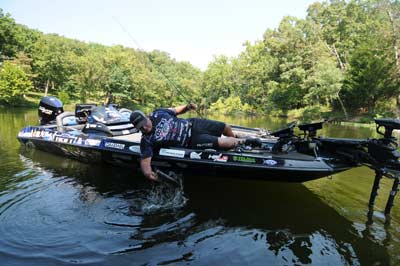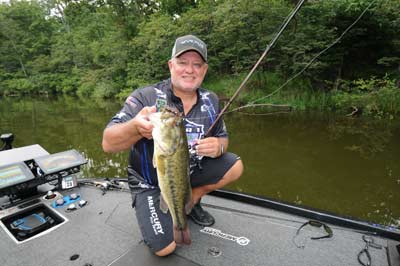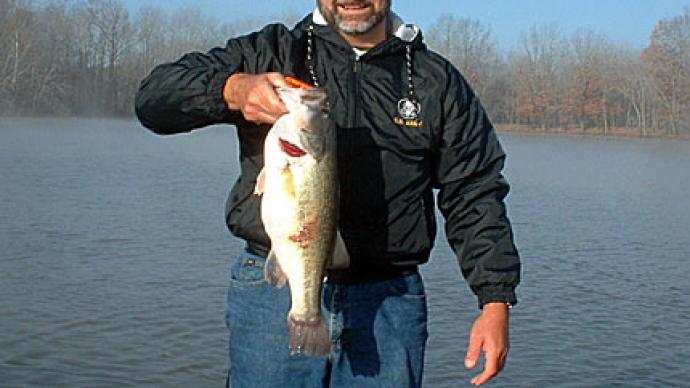
When it’s 100 degrees with bright, blazing-hot sunshine at his home lake, Jeff Hoots fishes in the opposite direction of most anglers.
During the heat of summer, most anglers avoid coves and flock to the main lake, where they probe for bass, seeking cooler, deeper water. Hoots also fishes the main lake when the dam pulls water and creates current, which draws baitfish and bass to offshore structure. However, when the dam shuts off the flow and baitfish and bass scatter and suspend on the main lake, Hoots heads for the shallows of the creeks and coves.
“Fishing shallow is kind of like a secret weapon sometimes during the summer,” Hoots says. “You can catch bass deep in the summertime for sure, especially if (the lake's dam) is pulling current. You can get out there and throw (Strike King) 6XD crankbaits and big worms and stuff, but that kind of fishing gets a lot of pressure this time of year. Then people forget about bass in the back (of coves and creeks). There are always bass, at any time of the year, living near the backs of creeks."
Even when the water temperature in the shallows of the coves soar to 88 degrees and higher on his home reservoir, the Lake of the Ozarks guide (tier1guideservice@aol.com, 314-0226-3701) targets bass ranging in depth from 1 to 10 feet. Hoots’ keys to catching shallow summertime bass are finding the coves and creeks filled with shad and cover providing shade. "With the shad and the shade, there is no need for quality bass to move (deeper)," he says.
Hoots' favorite targets for shallow summertime bass are boat docks and any wood cover. "Bass can get up under docks and lay in the shade around corners where they can ambush the shad,” he says.
The Missouri guide passes up boat docks and wood cover halfway back in coves or creeks and starts concentrating on any cover less than 10 feet deep. “I always check the last deepest piece of cover whether it be a dock, log or laydown leading into the backs of the creeks where it does get real flat and shallow,” says Hoots, who believes shallow cover offers the highest percentage spots to catch bass in the creeks. "The bass that are moving towards the back or in the back are there for one reason: to eat. So the fish that are in transit in between, unless you get lucky and happen to be in the right place at the right time, you will probably not catch a lot doing that."
The regional tournament angler suggests the stained to murky waters of coves and creeks in the upper tributary arms of a lake are better for catching shallow summertime bass than the clear water shallows on the impoundment's lower end. Hoots favors off-colored water because bass will linger on the edge of the cover better, whereas in the clear water, bass tend to burrow into the cover, making them harder to reach. The guide claims the backs of coves and creeks featuring clear water can also be productive if the lake experiences a bountiful baitfish hatch that supplies plentiful forage for shallow bass.

Sunshine and a slight breeze are the ideal weather conditions for Hoots’ shallow summertime patterns. The sunshine causes bass to move into the cover for shade and makes it easier to target the fish, while the breeze pushes plankton towards the cover where shad feed on the microorganisms and move dangerously close to the bass’ ambush point.
Hoots’ favorite lure combination for tricking shallow summertime bass is a brown-and-blue 5/16-ounce Erion Breaker Jig with a green pumpkin Bojangle Baits Cook Craw or Zoom Critter Craw that he pitches on a 7-foot medium-heavy or heavy action casting rod with a fast tip and an 8.5:1 baitcast reel filled with 18- to 25-pound fluorocarbon line. Another lure he or his clients pitch to shallow cover is a shaky head worm consisting of a 7-inch Bojangle Baits Trickster worm rigged (green pumpkin for clear to stained water or black and blue for dirty water) on a 1/4-ounce Croc-O-Gator Shaker Pro Head jighead.
After pitching his jig to a dock or some shallow wood, Hoots lets the lure fall straight to the bottom. “The bass usually grab it and swim with it before you even feel the bite," Hoots says. If the jig reaches the bottom, Hoots usually reels it in and pitches to another shallow target.
When he encounters finicky bass, Hoots changes his jig presentation. If a bass fails to hit the jig on the fall, Hoots gives the lure a quick, hard pop with a snap of his wrists to trigger the bass into a reaction strike. "That makes the jig jump off the bottom about a half a foot or a foot or so, and the bass' natural instinct is to react and grab it,” Hoots says.
Hoots pitches his shaky head worm to targets, and after it falls to the bottom, he drags it back through or around the cover. "That is more of a bite that you will feel because you are dragging it, and the fish will bump it a lot of times," he says. "So you will either feel the weight of the fish on there or a tick."
When he finds aggressive bass in the shallows, Hoots casts a smaller square bill crankbait (1.5 or 2-inch model in shad patterns or chartreuse hues) on a 7-foot medium-heavy action Halo Fishing Cranking II Series rod and a Team Daiwa Zillion 10:1 or baitcast reel spooled with 12- to 20-pound Sunline Super FC Sniper Fluorocarbon line. The guide retrieves the crankbait at a high speed and bounces it off the cover to create a reaction strike.
Hoots has caught numbers of bass in the 2-pound range and quality bass in the 4- to 6-pound class when fishing the shallows during summertime.
If it's a hot, sunny summer day and baitfish are present, Jeff Hoots and his clients will likely be in the back of a cove or creek catching bass in the shallows.




